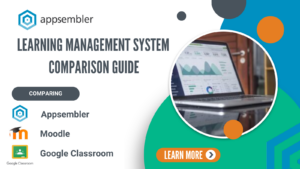While training can often be seen as a cost center, if delivered effectively, it can be an immensely useful tool for attracting talent, onboarding new hires, and upskilling existing employees to meet talent gaps.
Take millennials. They became the largest generation in the workplace in 2016. They also prioritize learning and development. The biggest draw for millennials when looking for a new job is the opportunity for progression; in a recent survey, more than half of millennial participants said that the opportunity for progression made an employer an attractive prospect.
Yet, millennials and Gen Z –– who are expected to cause an influx of roughly 60 million job seekers in the next decade –– are used to doing almost everything online, from shopping to booking appointments to communicating and learning. Just take a look at the rise in the number of registered edX users, which grew 161% from 2019 to 2020 to a total of 35 million individual users.
One important part of these online learning courses is self-paced training and the ability to learn at a pace that suits each individual’s schedule and needs, whether it’s at work or at home. This article will look at why self-paced training is so important and how it can benefit your employees, reduce training costs, and improve engagement.
Self-Paced Training and the New World of Work
As a result of the Covid-19 pandemic, companies and employees have both experienced the potential of remote work. Many companies will likely never return to the traditional 9-5, five-days-a-week routine that was the pre-pandemic norm. By working remotely, employees can simultaneously be more productive while also maintaining a better work-life balance with no lengthy commutes and fewer in-office distractions.
Classroom-based, instructor-led training doesn’t fit well with a post-Covid society. When employees have found that they can work just as well from home, or with a hybrid home-office model, why would they subscribe to a one-size-fits-all approach where they must attend training at a certain time in a specific location?

And as digital natives enter the workplace, they may also view this type of training as outdated and old fashioned. If their onboarding training consists of the inconvenience of attending in-person, classroom-based workshops, will they stick around for the long haul? Or will it rub them the wrong way, creating the fissure needed for them to jump ship when a more modern company offers them the opportunity to learn from anywhere and work from home?
What about your instructors? If you were flying them around the world to deliver training pre-pandemic, then you’ve probably already adapted your training to the post-pandemic world. Will your instructors want to travel again now that they’ve grown accustomed to giving training remotely or see the growing popularity of self-paced, online training?
Effective and Engaging Training
One issue that comes up when talking about self-paced training is how can you ensure that your employees are completing the modules and making their way through the course at a suitable pace.
One survey found that self-paced online training is the most popular form of training among employees. It’s also a highly effective form of learning new materials and skills. A study carried out by The National Center for Biotechnology Information found that self-paced learning significantly improves memory performance.

Self-paced training can also help you create more personalized learning experiences for employees, rather than delivering the same training regardless of role, experience, or career path. Not everyone learns in the same way, and by recognizing that, you can create course content that resonates with users and that they are more likely to commit to and complete. In fact, Gen Z highly values learning that is personalized to their role and career goals.
Reduce Costs and Better Measure Performance
Self-paced training can help you make the most of your training budget because it scales at a very low cost. Once you’ve created the content, you can deliver it to an unlimited number of users. If you need to make changes to the content, you don’t need to brief your instructors to change their PowerPoint presentations. Instead, you can do it with a few clicks.
Not worrying about instructor availability (or schedules) or updating content are two ways that self-paced training takes the burden off of instructors and L&D teams. For example, instructors won’t have to worry about setting up computers or wasting half the training session making sure everyone has the right software installed. You’ll also be able to save travel, hotel, and office costs and you won’t have the inconvenience of trying to schedule a time that suits all participants.
With self-paced training, you can easily monitor engagement and performance by tracking overall course metrics, as well as individual learner metrics. You can track enrollment and completion, and spot any areas where users struggle or where they drop off. This allows you to optimize your course content to boost enrollment, engagement, and completion.
When you have this data, you can easily report training performance to management and make the case for extending and expanding your employee training programs based on the most successful courses.
Creating Interactive Learning Experiences
Learning by doing –– or experiential learning –– is a highly effective and necessary component of any training course, particularly if you’re training employees on how to use software. Observational learning methods (where the instructor shows users what to do) will only get you so far. But when you create self-paced, interactive learning environments complete with software sandboxes, learners can get the type of hands-on experience that will help them better absorb the course’s training content.
Appsembler for Online Training enables you to deliver self-paced training experiences to employees, while Appsembler Virtual Labs provides them with the hands-on software sandboxes they need to truly become proficient users. The combined solution is scalable and helps to increase the quality of the courses you are offering to your employees.




